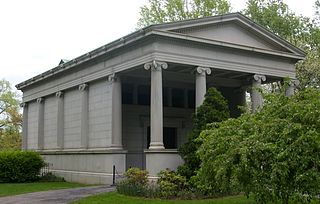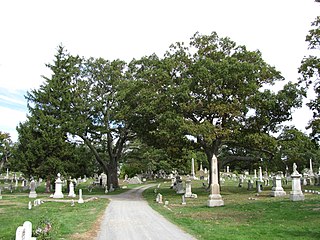
Mount Auburn Cemetery, located in Cambridge and Watertown, Massachusetts, is the first rural or garden cemetery in the United States. It is the burial site of many prominent Boston Brahmins, and is a National Historic Landmark.

Old Chapel Hill Cemetery is a graveyard and national historic district located on the campus of the University of North Carolina at Chapel Hill in Chapel Hill, North Carolina.

Capon Chapel, also historically known as Capon Baptist Chapel and Capon Chapel Church, is a mid-19th century United Methodist church located near to the town of Capon Bridge, West Virginia, in the United States. Capon Chapel is one of the oldest existing log churches in Hampshire County, along with Mount Bethel Church and Old Pine Church.

Spring Grove Cemetery and Arboretum is a nonprofit rural cemetery and arboretum located at 4521 Spring Grove Avenue, Cincinnati, Ohio. It is the third largest cemetery in the United States, after the Calverton National Cemetery and Abraham Lincoln National Cemetery and is recognized as a US National Historic Landmark.

Westland Mansion was the home of Grover Cleveland, the 22nd and 24th president of the United States, from his retirement in 1897 until his death in 1908. The house is located in the historic district of Princeton, New Jersey, and is a National Historic Landmark also known as the Grover Cleveland Home.

Wade Memorial Chapel is a Neoclassical chapel and receiving vault located at Lake View Cemetery in Cleveland, Ohio, in the United States. It was donated to the cemetery by Jeptha Wade II in memory of his grandfather, cemetery and Western Union co-founder Jeptha Wade. The overall design was by the newly-founded Cleveland area architectural firm of Hubbell & Benes, and was their first commission. The interior's overall design is by Louis Comfort Tiffany based on a preexisting 1893 design. The interior features two mosaics on the right and left hand walls, and a large stained glass window.

Samuel Burdsal House is a registered historic building in Cincinnati, Ohio, USA, listed in the National Register on June 10, 1982.

Hugh Campbell House is a historic building near Harrison, Ohio. It was listed in the National Register of Historic Places on November 7, 1976.

Samuel Hannaford House is a registered historic building located at 768 Derby Avenue in Spring Grove Village, Cincinnati, Ohio. It was listed in the National Register on March 3, 1980.

Greenwood Cemetery is a registered historic district in Hamilton, Ohio, listed in the National Register of Historic Places on July 22, 1994. It contains 5 contributing buildings. Greenwood is designed in the style of a landscaped park and garden with mortuary art and statues among the graves.

Cleveland Township is one of fourteen non-functioning county subdivisions (townships) in Rowan County, North Carolina that were established in 1868. The township had a population of 2,817 according to the 2010 census. The only incorporated municipality in Cleveland Township is the town of Cleveland. Residents are served by the Rowan–Salisbury School System and the township is home to Mt Ulla Elementary School.
Spring Grove Cemetery is a nonprofit garden cemetery and arboretum in Cincinnati, Ohio.

The Oak Grove Cemetery is a historic cemetery, founded in 1854, which is bounded by Derby, Washington, and Grove Sts., and Maplewood Avenue in Gloucester, Massachusetts, United States. The cemetery was founded by a group of local businessmen who sought to establish a cemetery in the then-fashionable rural cemetery style. They hired landscape architects Robert Morris Copeland and Horace William Shaler Cleveland to lay out a series of winding lanes. The Bradford Chapel was built through a bequest by George R. Bradford, another local businessman, and built in 1903–04. The cemetery is still privately owned, and has grown over time to occupy 11 acres (4.5 ha).
Charles Emmett Cassell was a Baltimore, Maryland-based architect.

Monnett Memorial M. E. Chapel is a historic church at 999 OH 98 in Bucyrus, Ohio.

Riverside Cemetery Chapel is a historic chapel located in Riverside Cemetery at 3607 Pearl Road in Cleveland, Ohio. It was built in 1876, received an addition in 1897, and closed due to disrepair in 1953. It was added to the National Register of Historic Places in 1987. It underwent a major renovation beginning in 1995, and reopened in 1998.

Oakwood Cemetery Chapel is a historic chapel at 2420 Oakwood Drive in Cuyahoga Falls, Ohio.

Spring Grove Cemetery is a cemetery on Main Street in the Clay-Arsenal neighborhood of Hartford, Connecticut. Established in 1845, it is one of the city's oldest cemeteries, and its first private non-sectarian cemetery. Its burials include a number of the city's high-profile civic and business leaders, as well as a substantial indigent population, and artist Frederic Edwin Church. It was listed on the National Register of Historic Places in 2011.

















